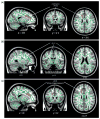Diffusion tensor imaging detects white matter abnormalities and associated cognitive deficits in chronic adolescent TBI
- PMID: 23472581
- PMCID: PMC4164967
- DOI: 10.3109/02699052.2012.750756
Diffusion tensor imaging detects white matter abnormalities and associated cognitive deficits in chronic adolescent TBI
Abstract
Primary objective: This study examined long-term alterations in white matter microstructure following TBI in adolescence using diffusion tensor imaging (DTI). It was hypothesized that white matter integrity would be compromised in adolescents with TBI and would correlate with measures of executive functioning and cognitive abilities.
Research design: This study employed whole-brain, voxel-wise, statistical comparison of DTI indices in youth of 12-17 years old (mean = 15.06) with TBI vs an age- and gender-matched cohort (mean age = 15.37).
Methods and procedures: This study scanned 17 adolescents with complicated-mild-to-severe TBI, 1-3 years after injury, and 13 healthy adolescents. Tract-Based Spatial Statistics (TBSS) was employed for DTI analysis.
Main outcomes and results: Overall diffusivity elevations were found in the TBI group with increases in axial diffusivity in the right hemisphere. White matter integrity was associated with word reading, planning and processing times in the TBI group, but not healthy controls.
Conclusions: The detected abnormalities in axial diffusivity may reflect neuronal regeneration and cerebral reorganization after injury. These findings provide tentative evidence of persistent white matter alteration following TBI in adolescence. Associations of DTI indices with cognitive performance following TBI provide tentative support for links between white matter integrity and performance post-TBI.
Conflict of interest statement
Figures



References
-
- Keenan HT, Bratton SL. Epidemiology and outcomes of pediatric traumatic brain injury. Developmental Neuroscience. 2006;26:256–263. - PubMed
-
- Access Economics. The economic cost of spinal cord injury and traumatic brain injury in Australia. [accessed 1 May 2011];The Victorian Neurotrauma Initiative. 2009 Available online at: http://www.accesseconomics.com.au/publicationsreports/getreport.php?repo....
-
- Langlois JA, Rutland-Brown W, Thomas KE. TBI in the US: emergency department visits, hospitalizations, and deaths. Centers for Disease Control and Prevention; Atlanta, GA: National Center for Injury Prevention and Control (NCIPC); 2006. [accessed 1 June 2011]. Available online at: < http://www.cdc.gov/ncipc/pub-res/TBI_in_US_04/TBI%20in%20the%20US_Jan_20...>.
-
- Casey BJ, Tottenham N, Liston C, Durston S. Imaging the developing brain: What have we learned about cognitive development? Trends in Cognitive Sciences. 2005;9:104–110. - PubMed
-
- Gioia GA, Isquith PK. Ecological assessment of executive function in traumatic brain injury. Developmental Neuropsychology. 2004;25:135–158. - PubMed
Publication types
MeSH terms
Grants and funding
LinkOut - more resources
Full Text Sources
Other Literature Sources
